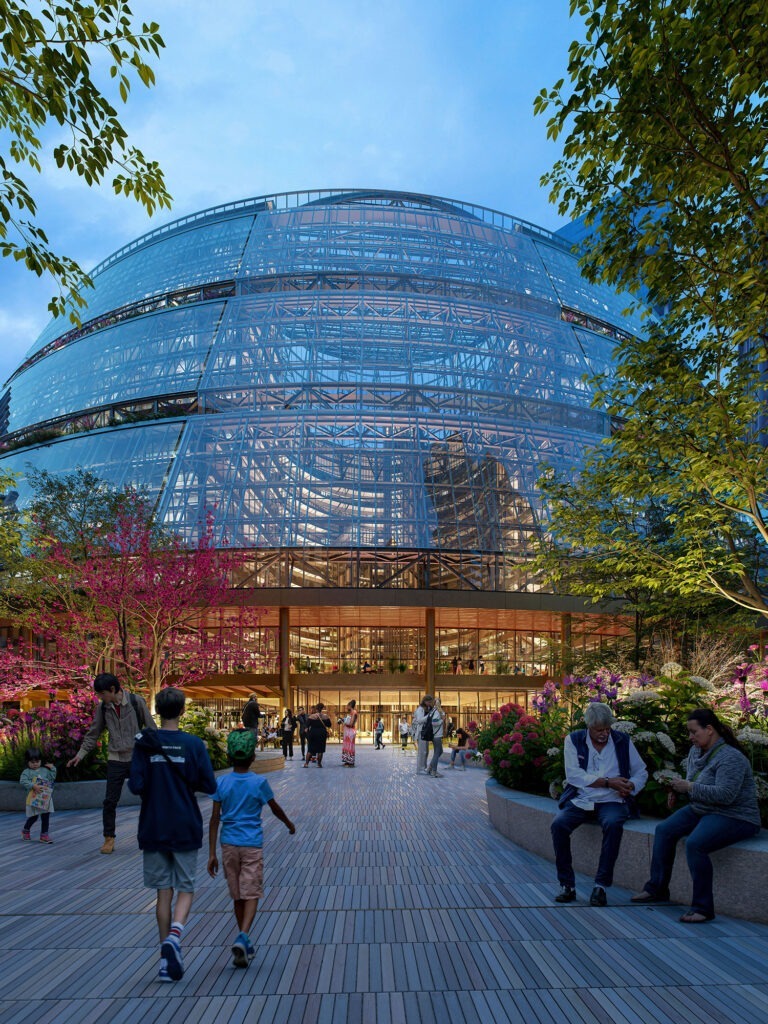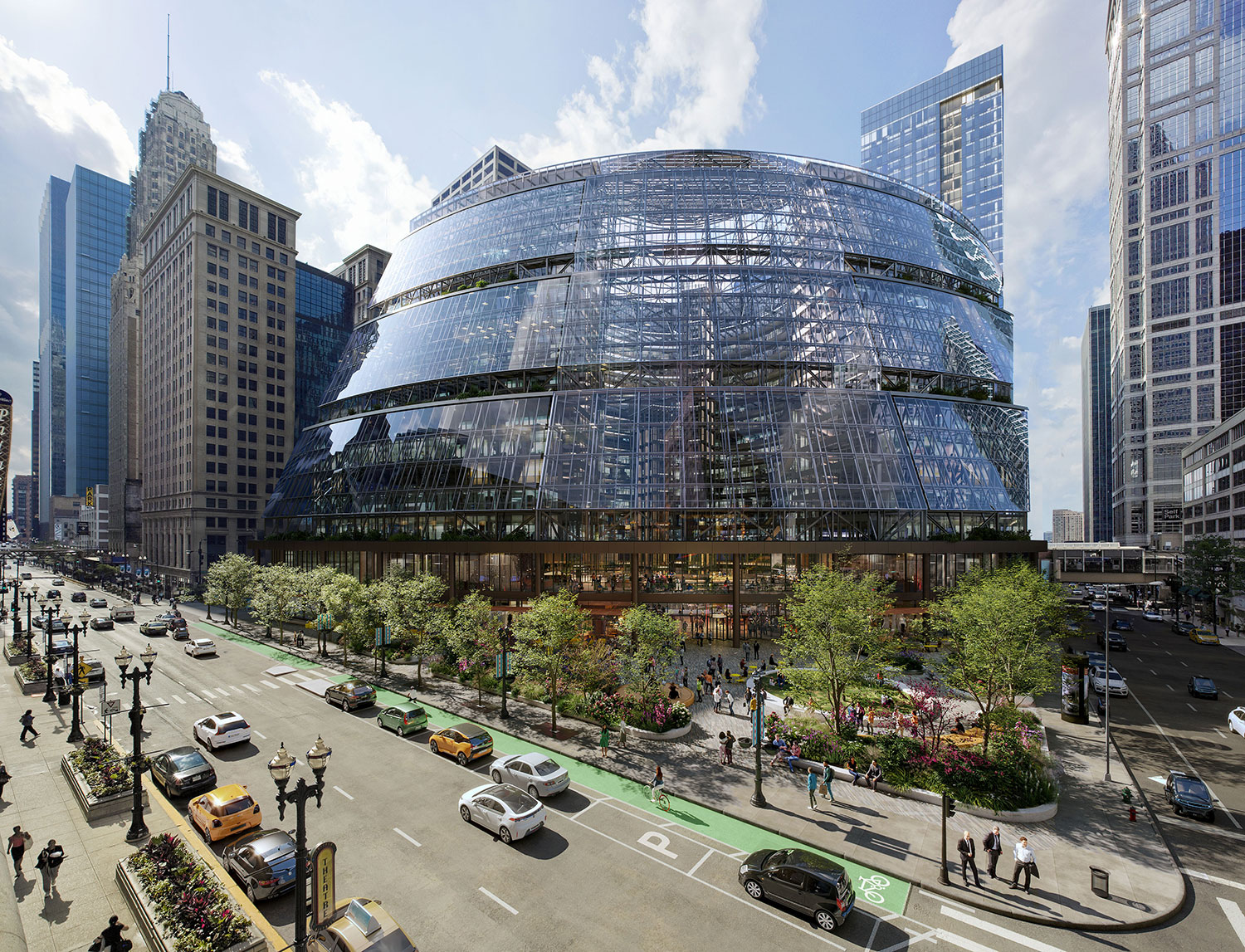“The idea of selling the Thompson Center is the right one, and hopefully someone buys the building and repurposes it,” the building’s architect, Helmut Jahn, told me when I spoke to him for a Chicago magazine story published back in May 2018.
At the time, the future of the beleaguered 17-story postmodern behemoth was uncertain, though state leaders had been actively selling the public on the idea that the site could and should be sold to a private developer, scraped and cleared to make way for the construction of a new supertall tower.
The city was experiencing a full-blown skyscraper boom, and when I spoke with Jahn, the city had 50 high-rises under construction. So it’d only make sense that whoever purchased and redeveloped the Thompson Center would want to go vertical to maximize the return on their investment.
The tropes about the Thompson Center were well known: The building was inefficient, the roof leaked, it was expensive to heat and cool, it was noisy, and the stench of fast food wafted up to the highest floors. To many, it was the ever-present physical embodiment of government waste. It was the building that Chicagoans loved to hate — a figurative architectural punching bag — but one that attracted visitors domestic and abroad.
Jahn didn’t want to see the Thompson Center unceremoniously pushed in and trucked off to a landfill. Neither did preservationists. When I first spoke with Jahn, the architect had linked up with Landmarks Illinois to produce a conceptual vision of the Thompson Center with a skyscraper addition jutting from the existing structure that could achieve a developer’s profit motive while also retaining much of the original building — a scenario that was pitched as a win-win-win for the State of Illinois, the building’s future owner, and preservationists.
“The last thing that will help the building is to tear it down. There’s an incredible opportunity to redevelop the building in a responsible way,” Jahn said during our call.
Jahn, like many of the Thompson Center’s critics, viewed the State of Illinois as an irresponsible, careless owner and wanted the building to go to a steward who would breathe new life into the aging 1.2 million-square-foot structure and proudly promote it as an exemplar of Chicago’s world-renowned architectural pedigree. And based on what Google Chicago Site Lead Karen Sauder shared in a blog post published last Wednesday, it appears that this is the kind of owner-occupier the tech giant plans to be with the building.
In many ways, it seems as though Jahn’s wish has come true. Jahn had a personal and professional motivation to see the building repurposed and rejuvenated — he was aware that his legacy was very much tied to his best known and most controversial work.
And while the latest reveal from Google sheds more light into their plan and timeline, it raises as many questions as it offers answers about how much of the original building will be preserved, how much access the public will have, and what place the building will ultimately have in Chicago’s storied architectural heritage.

The Loop Googleplex
In her recent blog post, Sauder offered new details such as a timeline for initial construction and a couple of new renderings. The building will be fenced off early next year and the renovation will “take several years to complete,” she said. In a previous blog post published in July 2022, Sauder indicated that Google plans to start moving into the building by 2026.
On the surface, the new renderings reveal a reimagined vision of the Thompson Center, notably absent of its signature salmon and light blue color scheme. There’s a bustling outdoor plaza, notably absent of the building’s companion sculpture. And there’s a new glass curtain wall that ditches the striped panels in exchange for a more uniform appearance.
But the building still looks like the Thompson Center — or the Loop Googleplex, or whatever the tech company will eventually rename it. And it would make sense considering that Google is working with Jahn’s firm — now headed up by Helmut’s son, Evan — on the project. The building’s exposed elevator shaft is still there, the circular rooftop dome will survive the overhaul, and the undulating exterior glass curtain will follow a similar form as the original.
Under the hood, Sauder said that Google plans to make the building all-electric and will “also replace outdated heating and cooling equipment with high-efficiency systems that are capable of managing Chicago’s famously varied seasons.” The company will seek a LEED Platinum designation for the overhauled project, the highest certification for energy efficiency and sustainability from the U.S. Green Building Council.
“For a building like the Thompson Center, this isn’t easy,” Sauder said of achieving this designation and efficiency goals. While Sauder doesn’t include a price tag in the blog post, undoubtedly, it is an ambitious and hugely expensive undertaking. Back in 2021 when Governor Pritzker’s office initiated the request for proposals process to sell the building, his office said that the estimated cost to update the building “into a state of good repair exceeds $325 million and is projected to increase to over $525 million by 2026.”
For a purely price-conscious buyer-developer, it’d perhaps be more cost effective to clear the site entirely and build new. Or at the very least, reusing the structure’s steel skeleton and cost-engineering a value-add build that monetizes every square-foot of the final product.
And this is exactly the scenario that preservationists and Thompson Center admirers (yes, they do exist) were concerned about when the first round of renderings were released during the announcement of the property’s sale to Google’s development partner Michael Reschke of The Prime Group. The images showed a bleak, cavernous space that lacked the soul and postmodern playfulness of the original building.
If the best case scenario was restoring the building with its historical elements in place, the worst case scenario would be transforming the structure into something that’s aesthetically and symbolically more akin to the Technodrome than an open and airy beacon of postmodernism.
While Google’s latest update offers more insight and some transparency into its plans for the building, other questions still remain. For instance, Sauder highlights a “new and improved CTA experience,” but doesn’t indicate exactly what that means. There’s some description of an “enhanced ground floor experience,” and “seasonal activations of the plaza,” but it’s unclear how much access regular citizens will have to spaces that were previously open to the public.
Sauder notes that when the Thompson Center first opened, it “was intended to be a new kind of gathering space for Chicagoans,” but then in the next line said that the overhauled building “will be perfectly positioned to welcome current and future employees from every corner of Chicago.” What does this mean? Are we just talking about Google employees here?
When reached for comment, a Google spokesperson responded simply, saying that “at this point, we’re not sharing anything about our plans beyond our blog post.”
But going back to preservation and Chicago architectural pedigree for a moment: Sauders said that “it was important to us that we honor the postmodern legacy of the building,” when choosing the Thompson Center as Google’s new Chicago office. While the high-tech structural expressionist spirit of the building is certainly one element to the Thompson Center’s postmodern cred, there are other more controversial elements that contribute just as much — if not more — to its postmodern aesthetic.
While it’s not exactly clear what Sauders means by honoring “the postmodern legacy of the building,” it is known that Google and The Prime Group are not seeking landmarking or a historical designation for the building that could provide incentives for the renovation. Perhaps it’s Google seeking a clean break from any government or public scrutiny over the redevelopment, or maybe the company sees more value in another future overhaul — say a Jahn-designed tower addition?
Related Content
The latest updates from Google is another reminder that the Thompson Center is no longer a government building. It seems safe to assume that the decades of bellyaching of government waste will finally be put to rest. But Google will still have plenty of government neighbors — Chicago City Hall just being one of them.
A Building for the Year 2026
When the Thompson Center first opened in 1985 — then known as the State of Illinois Center — the hope was that the ambitious project would not just be “a new kind of gathering space for Chicagoans,” but one that would become a catalyst for new investment in Chicago’s central business district.
And indeed, downtown Chicago witnessed a dramatic building boom in the mid-80s, seeing 148 new construction and renovation projects completed between 1985 and 1986 — including other statement piece skyscrapers, such as the Accenture Tower, also designed by Jahn’s firm.
The downtown construction boom of the mid-80s led to a subsequent glut of downtown office space and a vacancy rate of 17-18% in early 1987. Today, the overall downtown office vacancy rate is over 21% according to CBRE, thanks almost entirely to the pandemic and the corporate shift to a work-from-home or hybrid model.
And once again, the Thompson Center project is being touted as one that could help kickstart the Loop’s economic renewal. Google has been widely credited as something of a force multiplier in the West Loop’s dramatic redevelopment of the last decade where countless warehouses were overhauled — or demolished — and transformed into Class A office space for tenants like McDonalds, SRAM, Dyson, and others. But the West Loop has hit critical mass and investor focus is now returning to the Loop.
In coordination with the equally ambitious LaSalle Street corridor vision — a massive injection of capital that would see aging office buildings in the city’s old financial district converted into residential and mixed-use — the future Loop that Google could help spur and revitalize is one that elected officials and leaders in the private business community are cheering on. And construction of the Thompson Center will occur as more employers continue to return-to-office efforts.
The original Thompson Center was a star-spangled postmodern icon whose tagline was “A Building for Year 2000.” It was designed during a time when there was optimism about technology and the role it’d play in the future. But Google’s gut rehab of the Thompson Center is preparing the building for the year 2026 — a future where social media algorithms and AI play major roles in our individual lives and society at large, sometimes for better and other times for worse.
There are still a lot of questions about what the economy will look like in the next few years, what the future of work looks like, and what the old Thompson Center will eventually look like. But the old regime is out and the new one is in — the building has been saved and it will live on to serve a new purpose for the next generation of Chicagoans.



